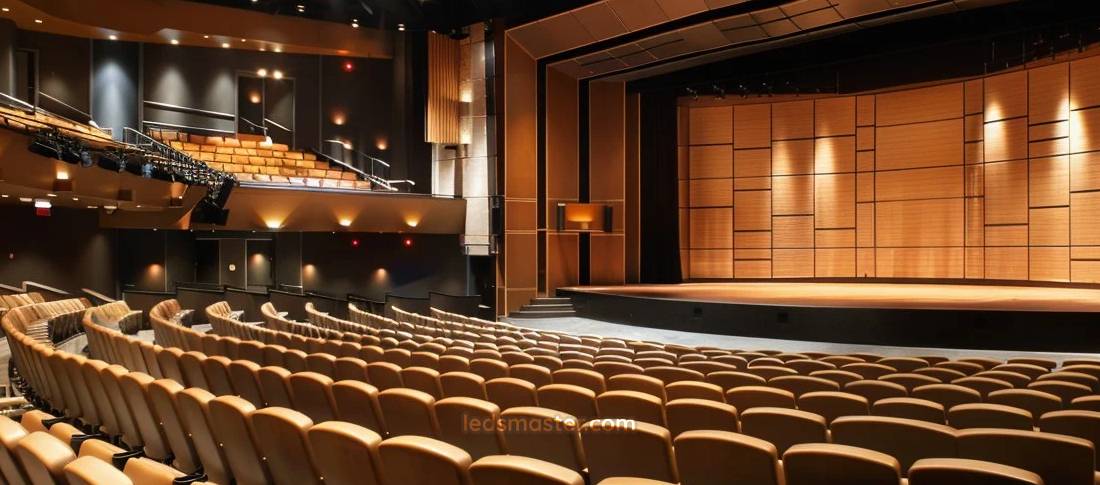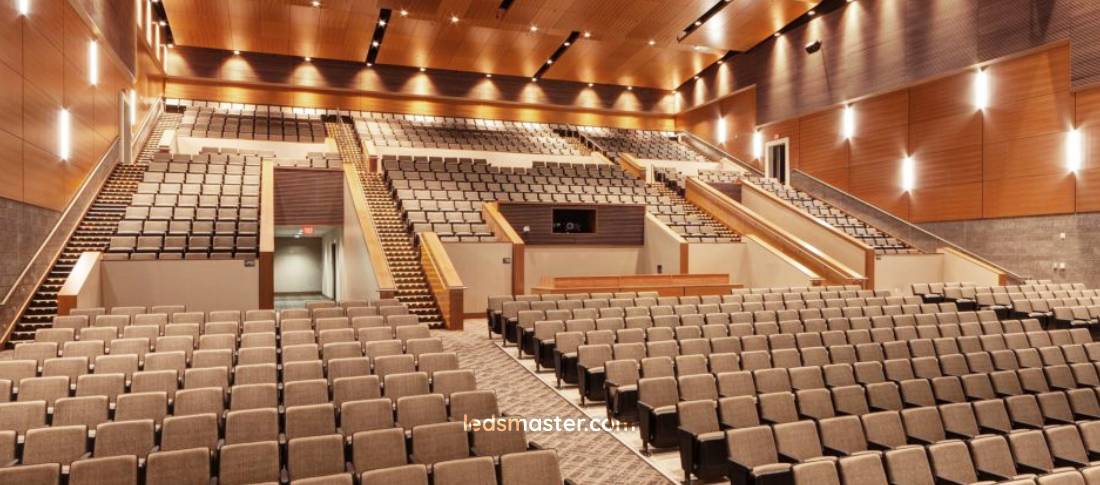Our auditorium lighting solutions are crafted to redefine ambiance with a perfect fusion of sophistication and practicality. Designed to elevate any venue, from grand theaters to intimate lecture halls, our products guarantee optimal visibility and create memorable experiences for every audience.
Explore the forefront of auditorium lighting innovation. Our products embody impeccable uniformity, exceptional brightness, and industry-leading Color Rendering Index (CRI), tailored for diverse venues. Through advanced technology and meticulous craftsmanship, our lighting solutions illuminate every detail with crystal-clear clarity, enhancing ambiance and ensuring unparalleled visibility for every performance.
Get your complimentary lighting design today
Table of Contents
ToggleA well-designed lighting scheme allows performers to shine while simultaneously creating an inviting atmosphere for the audience. It encompasses various elements, including the types of fixtures used, their placement, and the overall design of the lighting system. By understanding these components, lighting designers can craft spaces that elevate the experience for everyone involved.

Lighting is often referred to as the “unsung hero” of performance spaces. It not only illuminates the performers but also sets the mood and tone of the event. Different lighting schemes can evoke various emotions; bright, white light can create an energizing atmosphere, while softer, warmer tones can generate a sense of intimacy. The manipulation of light enables designers to guide the audience’s attention, directing focus toward specific actions or moments on stage.
A range of lighting fixtures is used in auditoriums, each serving unique purposes. Spotlights, floodlights, and LED panels are commonly employed to achieve different effects. Spotlights provide focused illumination on specific performers, while floodlights can wash the entire stage in color or light. LED panels are versatile and can create dynamic backdrops, adding depth and dimension to the performance.
Uniformity is one of then principles of effective auditorium lighting. It refers to the consistent distribution of light across the performance area, ensuring that performers are well-lit, regardless of their position on stage. Achieving this uniformity is essential for maintaining visibility and creating a professional-looking presentation.
Modern lighting systems utilize advanced technologies such as LED fixtures and intelligent lighting controls to ensure uniform lighting. LEDs are favored for their ability to produce even light distribution and minimize shadows, which is vital for performances that require intricate visual details.
Moreover, intelligent lighting controls enable real-time adjustments to light levels and distribution, adapting to the needs of the performance as it unfolds. This flexibility is particularly valuable during live performances where conditions can change rapidly. A well-lit stage not only enhances visibility but also contributes to the overall aesthetic appeal, allowing directors and lighting designers to create visually compelling narratives.
The level of brightness must be carefully calibrated to provide adequate illumination without overwhelming the performers or causing discomfort to the audience. This balance is particularly important in auditoriums where varying performance types may require different lighting intensities.
LED fixtures have become the standard choice for many venues due to their ability to deliver high brightness levels efficiently. Additionally, they offer flexibility in color temperature adjustments, allowing lighting designers to tailor the ambiance to suit the specific needs of the performance.
A well-lit stage allows for clear visibility of performers and their expressions, while excessively bright lighting can lead to glare and discomfort. Lighting designers must strike a careful balance to ensure that the illumination enhances the performance rather than detracting from it.
In an auditorium setting, where the visual fidelity of costumes, scenery, and facial expressions is paramount, high CRI lighting ensures that colors appear vibrant and true to life.
Warm tones can evoke feelings of comfort and intimacy, while cooler tones can create a sense of tension or urgency. The use of lighting to enhance color rendering can elevate the storytelling aspect of performances, allowing audiences to connect more deeply with the narrative.
The improvement provides designers with the tools necessary to create immersive and visually captivating experiences, making it possible to bring the performance to life in a way that resonates with audiences.
The evolution of auditorium lighting has brought forth the advent of dynamic lighting controls, which allow for unprecedented flexibility in lighting design. This capability is especially valuable in theatrical productions, where lighting cues play a crucial role in storytelling.
Dynamic lighting systems enable designers to create scenes that evolve throughout a performance, adapting to the changing narrative. Automated lighting systems can transition seamlessly between different scenes, adjusting intensity levels to highlight key moments. This adaptability enhances the overall production value and artistic impact, allowing for a more engaging experience for the audience.
Programmable lighting consoles further empower operators to execute complex lighting designs with precision. These consoles allow for the creation of intricate lighting sequences that can be triggered at specific moments during the performance. The ability to manipulate light dynamically not only elevates the visual presentation but also contributes to the emotional engagement of the audience.
For instance, during a dramatic scene, a sudden dimming of lights can create a moment of suspense, while a burst of brightness can signify a climactic event. By using lighting to reflect the emotional arc of the performance, designers can enhance the overall impact and captivate the audience’s attention.
As the world increasingly emphasizes sustainability, energy-efficient lighting solutions have become a focal point in auditorium design. LED technology has emerged as the leading option in this regard, offering substantial energy savings compared to traditional incandescent and fluorescent lighting systems.
Additionally, they boast a longer lifespan, resulting in lower maintenance costs and a decreased environmental footprint. These factors make LEDs an attractive choice for auditorium managers looking to implement sustainable practices.
Lighting designers are increasingly prioritizing energy efficiency by adopting LED fixtures and implementing intelligent lighting controls. These measures optimize energy usage without compromising performance quality. By embracing energy-efficient technologies, auditoriums can contribute to broader sustainability goals while delivering high-quality lighting solutions.

Lighting designers must consider various factors, including glare reduction, lighting uniformity in seating areas, and ambient lighting levels during intermissions or transitions.
Well-designed lighting enhances the viewing experience by drawing focus to the stage while maintaining comfortable illumination levels throughout the venue. Careful consideration of lighting angles, fixture placement, and dimming capabilities ensures that audience members can fully immerse themselves in the performance without distractions.
For example, effective glare reduction techniques can help minimize discomfort for audience members seated in certain positions. Additionally, adjusting lighting during specific moments in a performance, such as softening ambient lighting during intermissions, can encourage social interaction among attendees, fostering a sense of community within the auditorium.
By ensuring that the lighting complements the performance while also maintaining comfort, lighting designers can enhance the overall experience, making it more enjoyable and memorable for attendees.
Coordinated lighting effects can complement live music performances, enhance cinematic screenings, or synchronize with multimedia presentations.
Advanced control systems enable lighting designers to pre-program sequences that work in harmony with audio cues or video content. This integration adds layers of visual depth and emotional impact to live performances, transforming traditional auditorium spaces into dynamic multimedia environments.
For example, synchronized lighting effects can amplify the emotional intensity of a musical performance or heighten the dramatic tension in a theatrical production. By crafting a seamless blend of lighting, sound, and visuals, designers can transport audiences into the heart of the performance, creating a holistic experience that resonates on multiple levels.
Moreover, the use of projection mapping in conjunction with lighting can elevate the visual experience to new heights. By projecting images onto surfaces within the auditorium, designers can create stunning visual effects that complement the lighting design, enhancing the overall aesthetic and emotional impact of the performance.
As technology continues to advance, the possibilities for auditorium lighting are expanding. Innovations in lighting technology are set to further enhance the capabilities of lighting designers, enabling them to create even more captivating environments.
One emerging trend is the development of smart lighting systems that utilize artificial intelligence and machine learning. These systems can analyze audience reactions in real time and automatically adjust lighting settings to optimize the overall experience. Such adaptability not only enhances performance quality but also allows for a more personalized audience experience.
Additionally, the advent of solid-state lighting and advanced optics is paving the way for new possibilities in lighting design. These technologies offer greater control over light distribution and color mixing, allowing for more nuanced and dynamic lighting effects.
The integration of IoT (Internet of Things) technology into auditorium lighting systems is also gaining traction. This allows for enhanced connectivity and communication between various lighting fixtures, enabling designers to create more intricate and responsive lighting designs.
Despite the numerous advantages of modern lighting technology, there are challenges that lighting designers face when creating effective auditorium lighting. One significant challenge is balancing technical specifications with the artistic vision of the performance. Designers must navigate the limitations of the space, including budget constraints and existing infrastructure, to achieve the desired outcomes.
Lighting designers often work within financial limitations while striving to deliver high-quality lighting solutions. This requires creative problem-solving and resourcefulness to maximize the impact of available resources.
Furthermore, designers must also consider the long-term sustainability of their lighting solutions. Choosing fixtures that not only meet immediate performance needs but also align with future requirements can be a daunting task.
Successful auditorium lighting design is not a solitary endeavor; it requires collaboration among various stakeholders, including directors, performers, and technical staff. Communication is key in ensuring that everyone involved is aligned on the vision for the performance and the role that lighting will play in achieving that vision.
Lighting designers must engage in discussions with directors to understand the intended mood and atmosphere of the performance. By gaining insight into the director’s vision, lighting designers can tailor their designs to align with the overall artistic direction.
Additionally, collaboration with performers is essential to ensure that lighting supports their movements and actions on stage. Performers may have specific preferences regarding lighting angles, intensity, and color, and it is important for designers to take these preferences into account.
Their expertise in operating lighting systems, troubleshooting issues, and implementing designs is crucial for executing the lighting vision during performances. A collaborative approach fosters a sense of teamwork, resulting in a more cohesive and successful performance.
Auditorium lighting transcends mere illumination; it is a multifaceted component that influences every aspect of a performance. From achieving uniformity and appropriate brightness to optimizing energy efficiency and enhancing audience comfort, effective lighting design is integral to the success of events held in these spaces.
By focusing on dynamic controls, seamless integration with audiovisual systems, and future innovations, lighting designers can elevate the overall quality of performances while enriching audience experiences. The evolution of technology continues to open new avenues for creativity and expression, promising a vibrant future for auditorium lighting. As these environments evolve, they will continue to inspire, entertain, and engage audiences worldwide, playing a vital role in the cultural landscape.
The art of lighting design in auditoriums represents a unique blend of technical skill and artistic vision. As lighting technology advances, so too will the possibilities for creating stunning visual experiences that leave lasting impressions on audiences. By embracing innovation, collaboration, and a commitment to quality, lighting designers can shape the future of performance environments, ensuring that they remain relevant and impactful for years to come.